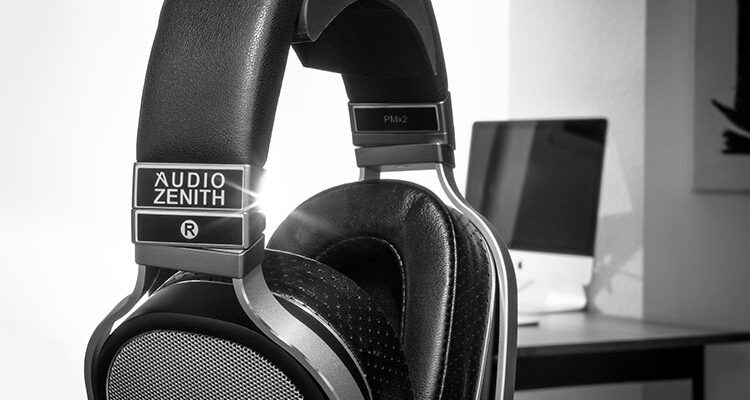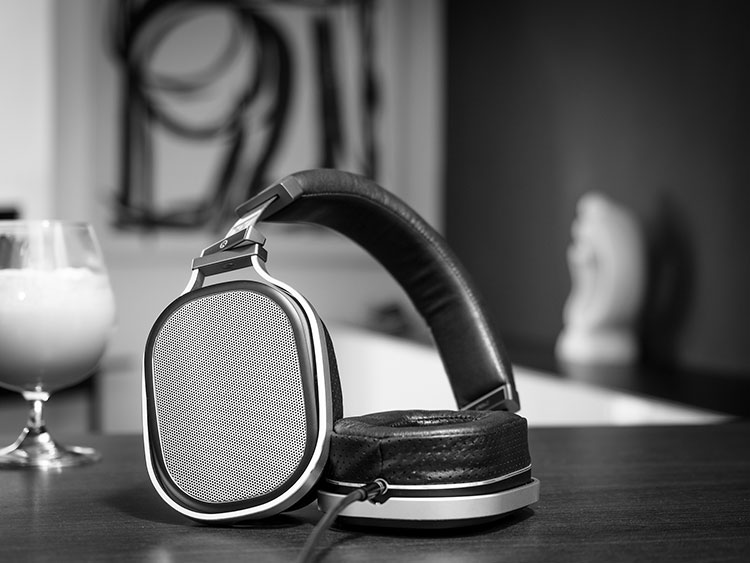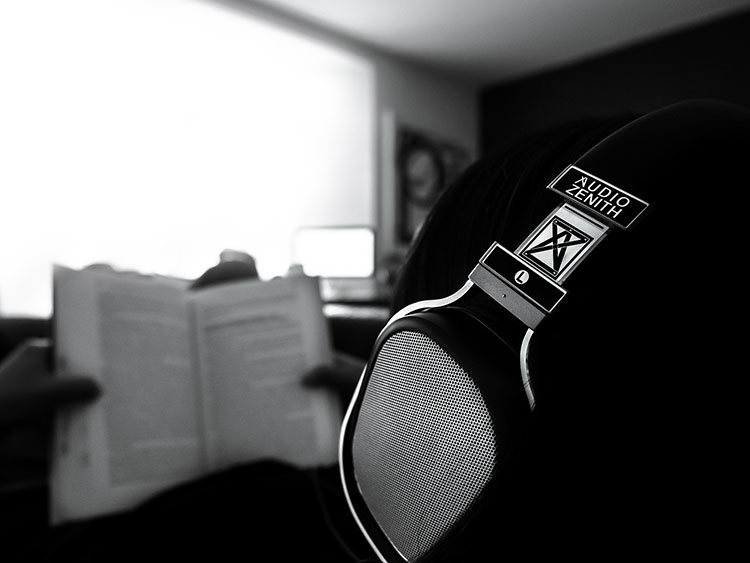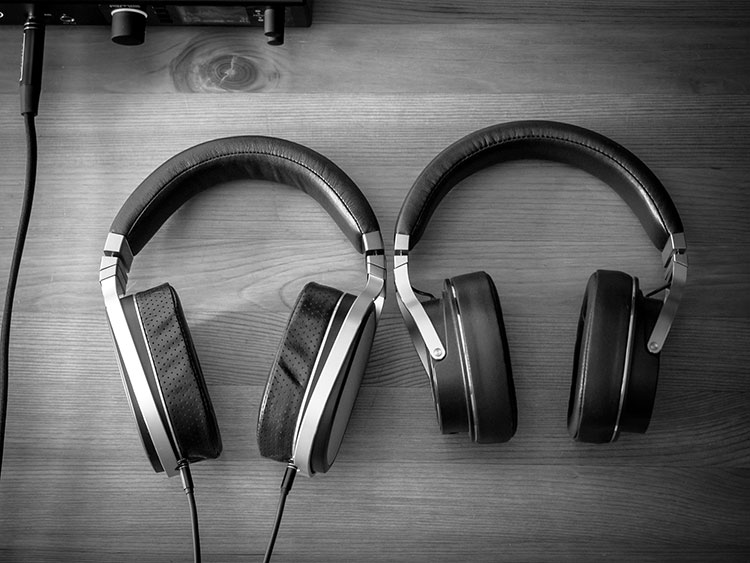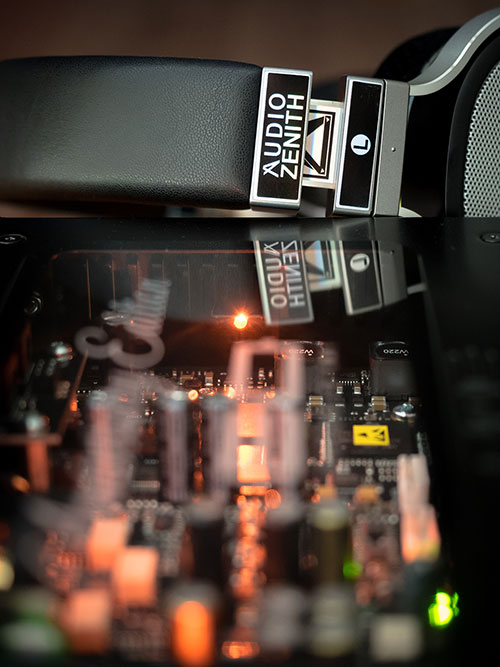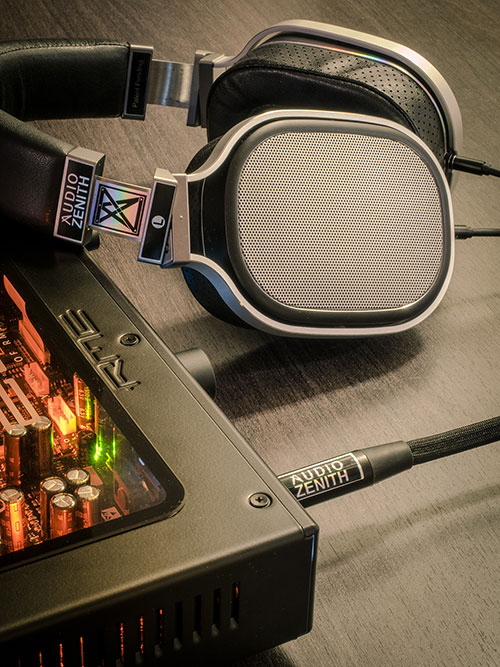The Audio Zenith PMx2 is a heavily modified Oppo PM-2 series open-back planar headphone design. It is priced at $899.
Disclaimer: The Audio Zenith PMx2 sent to us is a sample in exchange for our honest opinion. We thank the team at Audio Zenith for giving us this opportunity.
To read more about headphones we have reviewed on Headfonics click here.
Back in 2014 Kyle reviewed the Oppo PM-2 and concluded that the PM2 was an amazing set of headphones with only but a few flaws.
Kyle was not the only person to notice their potential. Luckily for us, one of the fans goes by the name of Alex Zaets; a dedicated audiophile with profound knowledge of audio design. He went through the trouble to modify the headphones’ base design and commercialized his modifications under the brand name Audio Zenith (maintaining his private name’s initials A.Z.).
His modification goes much deeper than adding or changing some dampeners and replacing the ear pads. His aim was to greatly enhance Oppo’s core design, precisely doubling it, for which he came up with the name „PM times two“ or in short, simply PMx2.
The Audio Zenith PMx2 can be purchased for 1.899 $ or optionally you can have your PM2 transformed irreversibly into the PMx2 for $899.
The Modification
The PM2
For your information concerning the following review: I am familiar with the original Oppo PM-2. However, I do not have them myself and I was not able to get my hands on them for a detailed comparison. My trusted headphone dealer informed me that the PM2 are not in production anymore. As of now, Oppo Digital has removed the PM-2 from their official website altogether. This could also be a threat to the PMx2 in the future, which heavily rely on the stock PM2.
A New Update
The PMx2 did not just recently surface. Audio Zenith has been popular in the scene for a while and garnered a lot of positive feedback for said modification. However, the unit of this review is a further update of said improvements.
Version History
The version history can be easily identified by the color of the ear cups’ grills which are colored silver since April 2017. Alex does not refer to the update as V2 or Mark II. Instead, he calls the current PMx2 “the final revision.” So if you are browsing second-hand markets, be sure to look out for the silver cups opposed to Oppo’s original black ones.
Unfortunately, the further modifications are not of the simple kind. Also, dealers have raised interest and thus the price had to be adjusted by 500 $. The original PMx2 went for 1399 $ as opposed to the updated 1899 $. For that, you are promised lower distortion along with higher resolution and a bigger soundstage.
New Ear Pads
A lot of the sound improvements come from the replaced ear pads. The original PMx2 had black velour pads that have now been replaced by lamb’s leather. They do share a similarity as in that their foam is separated into different zones with varying stiffness.
This is an incredible feature that many headphone manufacturers overlook altogether. I have to admit that I have a difficult time telling the different levels of stiffness apart, even when squeezing the pads with my fingers, but there is no mistaking the pads change the sound for the better. They feel comfortable and solid at the same time – if that makes any sense.
 Mimicking a Room
Mimicking a Room
The pads themselves feel squishy and soft – perhaps not to the level of the softest memory foam – but as soon as you put the headphones on, you have the impression as if your ears were in an enclosed room. Now, this is a convenient description because Audio Zenith wants to have you think of a room in regards to the ear pads. In one of the videos on their homepage, Alex describes the sound in a triangle system and how the listener, speaker, and room translate to the ear, transducer and ear pads, respectively. I recommend checking out the videos if you have the time.
Complex Process
Of course, the modifications don’t stop there. The whole headphones are disassembled and there is a lot of tinkering involved. Audio Zenith was kind of enough to share details in a private conversation, but I was also asked not to share it. The process does sound almost painfully cumbersome. It made me realize how convinced Audio Zenith are that the modification is worthy of all the troubles.
Patent Pending
Audio Zenith attached a “patent pending“ sticker on the inside of one of the hinges. I could not figure out what this refers to. I do think it is a bold move to take the product of another company, to tinker with it and then trying to put your patent on it. I’d prefer if the sticker were not there.
Packaging & Accessories
The review unit was sent across the sea and arrived safely in Europe. The outer boxing is by Oppo but rebranded to Audio Zenith with a sticker. It is one of the lighter packagings you will find among high-end headphones. One could up the experience of unboxing with some more layers and fancy documentation. This would also distance the PMx2 better from the Oppo PM-2.
As is the packaging, the accessories are also taken over from Oppo. The headphones come with two cables and a surprisingly portable carrying case. The case is only slightly larger than that of the portable PM-3 headphones and it features a similar jeans texture design and black zippers. The cover is a bit softer, though, and I don’t recommend to accidentally sit on it. It does make a great travel case, though. The centered Oppo logo has been covered by yet another Audio Zenith sticker. Due to the texture on the case, I think this sticker lacks grip and will be the first (or only one) that will come off eventually.
Build Quality, Design & Comfort
The PM Legacy
Oppo Digital completely won me over with the beautiful PM-3 portable headphones. The design is very similar to the PM-2 and PM-1 with the lower numbers having an even better premium feel. I think there is hardly any headphone design out there that is significantly better than that of the Oppos – at least not in a traditional design that does not exceed the usual size and weight.
Form Factor
Audio Zenith definitely chose the right model as a base here. The metal finish is outstanding and the headband is as simple as it is genius. The rasterization is rock solid. Weight comes in at just below 400g and they are distributed well over the head. Clamping force is more reminiscent of a portable design, perhaps, but it feels very good on my head nonetheless.
Stickers
Next to the replacement pads, there are a few different design cues, too. Audio Zenith covered up all original branding and used stickers to replace them with their own. Now that doesn’t sound too fancy and I have to agree that the original Oppo print looked better.
Design Cues
Yet the stickers match the overall design well. They are mostly black and silver but the silver reflects in rainbow colors. It is not flashy but noticeable. Audio Zenith told me that they do have an agreement with Oppo that allows them to cover up all of the original branding, which is nice from A.Z. to ask for in advance.
Silver Metal Trim
Interestingly, the headphones have a slim silver metal ring just next to the ear pads. This slim metal ring also reflects in the same colors. Now, this left me quite puzzled because the metal ring is from the original Oppo design. No other stock part reflects in the same colorful way. If Audio Zenith went through the trouble to replace it for a better match, I take my hat off!
Bugs
I do think the stickers could be printed in a higher resolution and I am slightly annoyed that the silver borders are asymmetrical. This is something to only bother the very attentive, like me for example.
Although it says Audio Zenith on the hinges, the actual AZ logo won’t show unless you expand the headband. I think that’s a cute detail. At first, the logo reminded me of some star-shaped symbols of which various pop into mind. It is, however, an overlay of the letters A and Z that have been adjusted for symmetry in a surround-sound speaker setup.
Ear Pads & Isolation
I already mentioned the ear pads before and how vital they are for this modification. They’re made from genuine lambskin leather. The pads are not angled as opposed to the previous PMx2 design with velours pads. Also, the zones have been rearranged accordingly.
On the inside of the right side, it looks like the leather had to be re-stitched but this could very well be an exception of the review unit. Even though the pads enclose the ears nicely, do not expect any isolation from any open-back headphones, for that matter.
Cable
Detachable
The PM2’s design features removable cables via 2.5mm connections on both sides. The PMx2 comes with the same two cables as the Oppo. The main cable is of very high quality, 3m in length and covered with cloth beneath the y-split.
It is thick and feels durable, yet doesn’t come off as too heavy. It terminates in a 6.35mm jack. The Oppo logo has once again been covered by an Audio Zenith sticker that doesn’t feel out of place at all. It fits perfectly in size and matches the dual-line design of the Oppo in color and size.
Second Cable
The second cable is 103 cm short and feels flimsy. This is very thin and has an annoyingly strong memory that keeps pulling itself back into the packaged circular shape. It has no branding at all. It is a welcomed temporary solution if your source only has a 3.5mm input but eventually, you will want to replace it.
The Oppo design does naturally support balanced cables. I think it would have been a nice touch if Audio Zenith could have replaced the short cable with a balanced cable instead.
Sound Impressions
Tuning
Reading up – and also witnessing – all the troubles Alex went through to create a reference-quality sound, I also expected a reference tuning. While the headphones sound natural and coherent for the most part, I find them to be a bit on the warm side with a slight fullness in the midrange.
The presentation is romantic and these headphones are a great support for an evening with a glass of red wine or a smooth bourbon. The treble is slightly recessed, though, and voices can take a step back while still having great body accentuated by a compelling low-end.
The PMx2 are a great example of how neutral and natural don’t have to be exactly in-line. The tuning is very easy on the listener and it shies away from any harshness. The coloration is very mild and it does not take away from any details in the music. The PMx2 are warm but not dark.
Bass
The bass response is fairly flat. There is no bloom or bleeding into the midrange, but the bass’ character is best described as textured and soft. The very low-end extension does not match the levels of an Audeze LCD (any of the series) and it starts to roll off a bit below 70 Hz.
However, the sub-bass is extremely tight and I had to edit this part of the review after I watched some movies. When the track allows to rumble, the bass is very impactful and precise. They do not achieve any head rumbling pressure levels, so the PMx2 are great for those that experience fatigue with too much boom. Please don’t mistake these for bass-light headphones, though. The details are all there; just don’t expect excessive punch or anything similar.
I think the headphones performed best with very low-tuned bass guitars that allow you to pick up single chords. Compared to the HE-560, the bass comes off as a bit bloated and it does not reach the same depth. But while the PMx2 sounds more compressed, they also feel tighter and create a more intimate connection to the low-end.
Mids
The midrange benefits from great body and just the right amount of fullness. The PMx2 develop their own character in a softer transition into the upper midrange. Precisely at around 2kHz, I notice a small dip that is only partly balanced at 3 kHz and thus maintains an overall mellowness.
The Hifiman HE-560 sounds a lot crunchier and I find the Focal Elear or Sennheiser HD 600 to have a slightly more convincing timbre. But there is something magical with the PMx2 and how voices arrange themselves among the instruments. They don’t pop out as much and they never jump in your face while still managing to portray intimacy. Consonants are slightly dull; at least my brain needed some adjustment. But after that, the tuning worked exceptionally well, especially for Rock music.
I kept asking myself whether I should or should not describe the midrange as veiled. But I don’t want to give a false impression that the mids sound like with the HD 650. The best I can describe it is with a reference to photo editing. It’s as if the blacks were lifted resulting in less contrast but also greater detail. So basically the PMx2 is your VSCO filter of high-end headphones.
Treble
I like my treble airy and I don’t mind its presence as long as it doesn’t have any noticeable peaks. The PMx2 are recessed by around 4 dB by my standards. They have a relaxed curve starting in the upper midrange but the high frequencies pick up quickly at around 9 to 10 kHz. This gives cymbals a nice shimmer and also great speed.
The definition of the treble is good while the PMx2 never crosses the border to sibilance. There is plenty of headroom for people who like to turn the volume up. While the treble has been improved, this is where the headphones can’t hide their Oppo PM-2 origins.
It immediately reminded me of said headphones, even if the PMx2 are more linear. I can’t think of any other headphones that sound similar. The high-frequency extension sounds natural to my ears. Overall, the treble is very enjoyable and I find it to have less coloration than both the Focal Elear and Utopia, nor does it have the darkness of LCD-2, but it also lacks the precision and realism of HE-560 or the new MrSpeakers Æon.
Soundstage & Resolution
The PMx2 does a great job of presenting the music outside your head. I always had to double-check my sources if crossfeed was deactivated because the sound spans like a halo around the listener. However, this halo is relatively close to the head so I don’t rate the soundstage as expansive. Neither in-depth nor width. However, it is is very cohesive and imaging is great. The LCD-2 provides more soundstage depth, but it also feels like you are sitting in a small chamber. The PMx2 places you in a bigger room but it is world’s apart from the expansive outdoor concert feeling you get from the Sennheiser HD 800.
Resolution is very high, but it is one of the kinds that awards attentive listeners. Due to the natural-relaxed tuning, there are no details that jump into your face. The Sennheiser HD 800 or AKG K 812 can be a lot more forward. But that should not fool any listener. The tightness and speed of Audio Zenith can easily keep up with other top-of-the-line headphones. They do veil details just a bit more. That makes them sound very compressed but at the same time, it adds to the homogeneity and causes less fatigue.
Matchability
The PMx2 are just as easy to drive as any Oppo planar magnetic. That is good news for fans of loud music. So, yes, there is enough power coming out of an iPhone, but it does not do these headphones justice.
RME ADI-2 Pro
In my review of the RME ADI-2 Pro, I ascribed a very subtle warm tint from the amplifier section. This does result in a very organic reproduction – dare I say analog? Nah, we stopped using this comparison. The RME adds crispness and tightness to the PMx2.
You can hear a slightly improved clarity with the Slow filter, something that is generally not easy to pick up and just shows the capabilities of the headphone’s speed. Having a PEQ at hand, I could not help myself using a sinus-sweep and adjusting the Audio Zenith to a more neutral reproduction.
If anybody’s interested, I’ll drop my recommended settings in the comments below. This does turn the PMx2 into a very different sounding headphone. Nonetheless, for some recordings and especially online clips, I preferred the stock tuning. Being able to switch back and forth between versions at any time made the ADI-2 Pro my preferred source for the PMx2. This is a great combo.
Chord Hugo 2
With the Chord Hugo 2, I feel comfortable at something around red to yellow (with -10 dB volume leveling in JRiver) which does not even exceed 1/4th of the available power with a ridiculous amount of headroom. The treble clarity of Hugo adds to the PMx2, though, while still maintaining a rich sound with great body and terrific contours. The crossfeed is a welcome addition that expands soundstage depth without noticeably coloring. I would almost say this combo is overkill, the Hugo 1 might be just as an easy recommendation in this pairing. The resolution is insane with either Hugo.
Shanling H1
Just as a showcase for the PMx2’s high matchability, I will mention the portable budget amp H1 by Shanling. The sound does feel a bit compressed and the treble is a bit brittle, but overall the sound is rich, warm and spacious. There is no need to switch to high gain, either. You can get more softness out of the PMx2 and also the slightly better layering of instruments. If you laid your eyes on the PMx2, money is probably not that much of an issue anyway, so I doubt this will turn out to be an often-seen combo within the community.
Our Verdict
Audio Zenith asked me many times to enjoy the music while writing this review. That is exactly what I did! I enjoyed my time with the PMx2 a lot and eventually, it even made me question the perception of warmth. At the end of the day, the PMx2 had me convinced that their tuning is very enjoyable and natural with not a hint of fatigue. It’s all about music first and that’s where the PMx2 excel at.
Modifications are a subject on their own. No doubt the upgrades done with the PM2 are troublesome and the PMx2 are a further development toward high-end audio. However, I do think that Audio Zenith was a bit too aggressive in covering up Oppo’s base work of a good headphone. Less of those Audio Zenith stickers would have sufficed too. Perhaps something along the lines of “PM2 reworked by Audio Zenith“ could have worked too. But the point is that the team of A.Z. put a lot of work into the PMx2 and the outcome is something to be proud of. This is a very refined product.
I can only recommend to check these out if they are available anywhere near you. Looking at the street prices, I think it might be easier to recommend to grab an Oppo PM2 as long as they are still available and then send them out for modification – this should be cheaper than paying full price for the PMx2. That is not saying they aren’t worth it, but it could make the investment even more worthwhile.
Audio Zenith PMx2 Technical Specifications
- Open-back, circumaural headphones
- Planar magnetic driver (85×69 mm)
- Frequency range: 10 Hz – 50 kHz
- Impedance: 32 Ω
- Sensitivity: 104 db/mW
- Cables: 3m (6.35mm) and 1m (3.5mm)
- Weight: 395g

